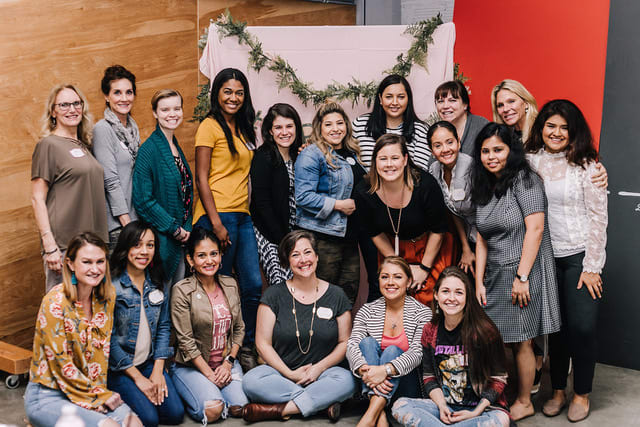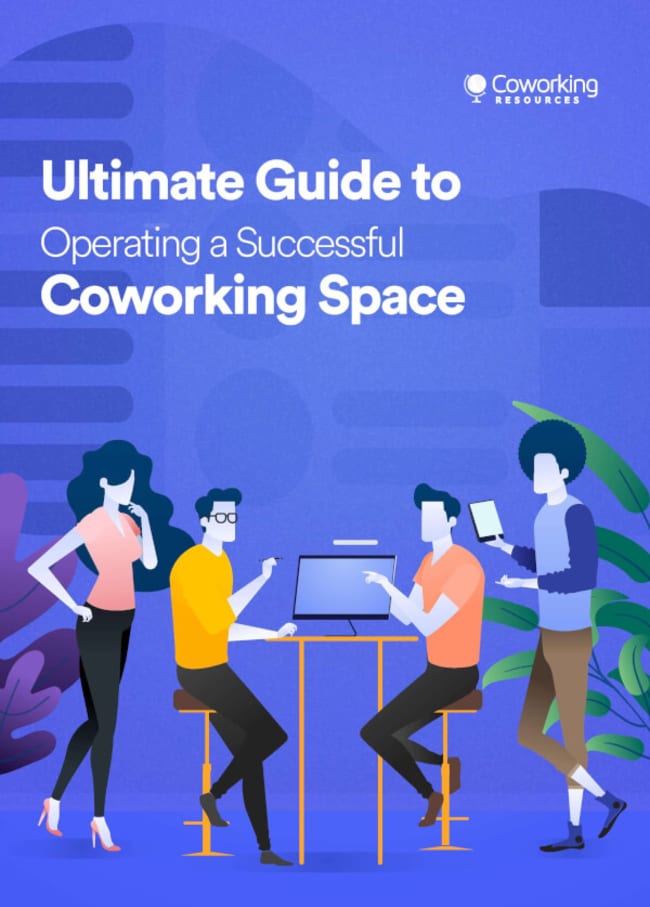Community Building
People are what make a coworking space a business.
01
Self-Sustaining

This post was written by Christine Andrews, the owner of Toronto-based Acme Works.
I opened the doors of Acme Works in June of 2013 and I didn't have a community in place before I launched. The day after I opened, I walked through 9,600 square feet of awesome emptiness. I joked with friends and family that I had the largest office in the city—because I was the only person working at Acme Works.
A great deal has been written about how to build a community before you open, so I’m not going to write about that. I'm going to share my knowledge of how to build the ideal community after you open.
In my opinion, there are three phases to building a coworking community—attract people, curate and trust your membership.
Build Membership Quickly
If you have an empty space or a membership level below the number you require, your first step is to immediately attract members. We’ve all stood outside an empty restaurant deciding not to enter because there is no one else inside. We might be missing out on the best meal ever, but the emptiness of a space that should be filled begs the question, “Why is no one in there?”Coworking spaces are the same. People attract people.
While, in the long term, you don’t want members who are only motivated by low price it’s okay to bring these folks onboard in the early days. Offer deep discounts and free memberships. I did deals with two large teams and offered 75% off. I knew they were unlikely to stay longer than six months, but I brought 15 folks into Acme in my first month of operation that were here every day. These teams attracted others and I started to gain traction.
However, the challenge inherent in this approach is the quality of your membership. If you only attract people motivated by price then they will eventually leave for a less expensive option (both of the teams I incentivized left in favor of cheaper space). Additionally, if they join because they want a deal, and not because they want to be part of a collaborative environment, they will not engage with other members. This will result in minimal interaction and ultimately a high level of churn, as those who want collaboration go elsewhere; therefore, offering deep discounts is a short-term tactic and even while you leverage it you also need to focus on bringing quality members into your community.
Share Your Vision And Be Willing To Say “No!”
This brings us to the second step necessary to curate a healthy community: Ensure all members understand the values of your coworking space. Your narrative has to start with your values and the benefits of community. You are creating the story of your space. If you place community, collaboration and values first and communicate why these are a priority, you will attract members who share your vision. The ability to meet a potential member’s specific physical and budgetary needs are where you begin the conversation, but it’s what you communicate next that will help define your community.
It’s important you share your story with potential members up front. Watch to see how they respond when you speak about community and collaboration. Do they exhibit interest in your members and ask about opportunities to engage professionally and socially with them? If they only ask whether the private offices lock or how many meeting room hours they get take those comments as a cautionary note and talk further to understand if they could be a valuable addition to your community or not.
Once you have a base membership that is contributing revenue and energy to your space you need to learn to say NO to those looking for offices who are not interested in community. It is verydifficult to say “no” when you are at 40% occupancy; you have empty space and someone willing to pay for it; however, if you don’t begin to curate for quality members then you will continue to experience high rates of churn and you’ll never be able to build the type of community you need for long-term success.
Create Positive, Unexpected Interactions and Trust Your Members
When you have a growing community, and you’re attracting true collaborators, you can make your community self-sustaining. And yes, I’m talking about leaving meeting rooms tidy and emptying the dish washer; but, more importantly, I’m talking about members finding ways to collaborate, support and help each other, share learning and participate in member-initiated activities.
Your number-one priority should be to spend time learning what matters to your members then facilitate unexpected interactions and create opportunities for collaboration. Sometimes I describe my job as talking to people because that is the most important thing I do on a daily basis. It’s how I tell if a member is feeling isolated, needs help with a project, wants to celebrate a success or needs to find focus. Learn how to strengthen your member’s connection to each other through these conversations.
It’s also important to identify and leverage your “Super Members.” Those who love your community, sing its praises to anyone who will listen, and whom you can rely on to take a new member under their wing and facilitate collaboration on their own. Retaining these members is critical because they strengthen and enrich your community.
The final way I discovered how to make my community self-sustaining was to hand them responsibility. The first time I went on vacation I was so worried about what might happen. Would the members follow the rules or would it be mayhem without me? I didn’t have staff, at the time, so I left the members to their own devices. I asked them to respect the rules, treat each other kindly and take care of the space. And guess what? They did. Nothing got broken, no rules were violated, and the daily business of coworking continued. By trusting my members to do the right thing they rewarded my trust and did just that.
Remember, these tactics should not be executed in a linear fashion, you should apply them concurrently. Build your membership quickly. Apply discounting to attract members; but, don’t rely exclusively on this approach as it will work against you in the long term. Curate your community, share your vision, be willing to say “no” and focus on those members who value collaboration. Create positive, unexpected interactions between your members, leverage your super members and learn to trust your community.
Happy coworking!
Coworking Space Management Guide
A comprehensive guide to help you manage your coworking space.
Download02
Building Online

As part of your coworking space, you need to work to create an online coworking community. While many spaces focus on creating the community in person via things like events, this is not the only aspect of a community. You should also use social media and other online tools to grow the community. With the right types of online community building in place, you do not need to rely on constant community events to build a community.
10 Tips to Build Your Community Online

1. Build a Facebook Group
One of the very first things you should do to grow your coworking community online is to utilize Facebook to your advantage. Make a Facebook group specifically for members of your coworking space, which is separate from your coworking space’s Facebook page. This will let members interact whenever they want. You can encourage members to share milestones and news, as well.
2. Leverage on Other Coworking Facebook Groups
Your community-growing strategies for coworking do not need to center around your particular space. Consider joining some of the national and international Facebook groups dedicated to coworking, such as Coworking Worldwide. This will let you join an existing community of those who love coworking. Joining a coworking group will help you stay up to date on trends and news and get advice.
3. Make an Instagram Account and Hashtag
Your online coworking community should also include Instagram, allowing members to visually share experiences. While you cannot make a coworking group on Instagram, you can create an official account for your coworking space and use it to follow members and encourage them to follow you. Most importantly, create a hashtag or set of hashtags so members can easily share images of the space or even of their lives with each other.
4. Use Twitter
Your coworking online community should also include Twitter, as this is among the most popular social media platforms. Your approach to using Twitter will be similar to that of Instagram, although the content will be different. Be sure to create a hashtag for your coworking space.
5. Introduce New Members
One of the important aspects of a coworking community is ensuring that everyone knows all the other members. To help with this, take the time to introduce new members via your social media pages. This will help new members get acclimated and meet new people.
6. Hold Member Takeovers of Social Media Pages
To make social media pages feel like an expansion of your community, consider letting members take over the account for a few days or a week. This is particularly useful on visual platforms like Instagram, as it lets members share their perspective in a way that engages the rest of the community.
7. Use a Messenger System
Depending on your space, you may want to also offer some sort of instant messaging service where members can chat with each other in real-time, whether in the office or out of the office. This can help members feel connected to each other even when they have no physical interactions. This includes Slack channels, Whatsapp groups, Telegram groups and so on.
8. Encourage Online Partnerships with Local Businesses
When it comes time to set up your online community for coworking, consider partnering with local businesses and other coworking spaces. Pick a few in your community that have a strong reputation and work out a partnership where you each make posts supporting the other or even collaboration posts.
9. Don’t Overlook Any Social Media Platform
When it comes to creating your online coworking community, do not overlook any social media platform and listen to what your members want. Use Facebook, Twitter, Instagram, Snapchat, LinkedIn, and more, provided you can keep them updated and they will add to your community.
10. Join the Coworking Google Group
While Google does not get too much attention in terms of social media, the Coworking Google Group is a must-join for any space looking to enhance its community. This group is filled with advice for newcomers and veterans in the world of coworking. It is also a simple way to join an already-existing online coworking community.
03
Event, Workshops and More

Nurturing a community is a key part of your coworking space. Before you ever open, start working to create that feeling of a coworking community with events, then, open the space when it is still just partially occupied. Continue consistently engaging the members to ensure that people still feel in touch with each other. With a sense of community, people are more likely to become members or continue their memberships. To nurture your community, be sure to plan coworking events and workshops.

Tips to Nurture a Community
Have an Opening Event
Start your coworking space off on the right foot with a launch or opening event of some sort. At the very least, plan an open house so people can see your space before you open, which will encourage new memberships. You might also want to get community attention with events that will be useful to future members, such as networking or coworking workshops. At these preopening events, be sure to include a signup list, so you can gather the contact information of people who are interested in your space.
Lunch and Learn
Consider planning coworking workshops, such as lunch-and-learn sessions. During these, have a different member of the coworking community share their advice. This is a way for members to feel as if they get to share their expertise while everyone learns. If you supply the lunch, everyone will feel encouraged to attend and expand their skillset or just make new connections.
Supplement the member-led lunch workshops with the occasional guest host to keep things interesting. Gauge the interest of your members to see what combination of coworking-related skills to non-relevant skills should be the topic, such as networking vs. learning some origami. You also can get inspiration from national coworking events.
Need to learn more than how to nurture a community? We tips on how to make an effective coworking business plan here.
Speed Networking
Many people who choose to use coworking spaces do so as part of their networking efforts. Take this to the next level by incorporating coworking events that have the goal of networking. The perfect example is speed networking events that you announce within the coworking space and the area as a whole. Consider giving each networking event a theme, such as a specific industry, so members can make useful connections. Mix these with general speed networking to promote any useful connections.
Evening Happy Hours
To create that sense of a coworking community, do not make every single coworking event about work; include some that are purely for fun. The perfect example would be a weekly happy hour after normal work hours. Decide what drinks will be served or if members should bring their own drinks, and give each week a theme. The idea is for members to associate the community and space with fun as well as productivity.

Free-Pass Events or Open Houses
In addition to an open house before you launch your coworking space, continue the community outreach with open houses every once in a while. This can be an event that takes place after your peak hours to show potential members the space. Or it can include a limited number of free passes (with required registration) on a set day of the month or even once a week.
04
Community First

Meredith Wheeler, the founder of Sesh Coworking, a women-only coworking group in Houston, Texas, shares her experience building a coworking community first, then locating a physical space. Wheeler began her coworking community over a year ago and is planning to open the physical space in 2019. You can read our previous article about women in coworking, which features Sesh, here.

When others in the coworking industry learn about my model, Community First, Space Second, they all give me the look. It’s the look that says, “You’re doing it backwards.” Most spaces function on the model of open the space first, find the community to fill it later. In my opinion, however, this is not the best way to build a healthy, sustainable, long-term coworking business. In fact, the space first model can make it even harder to keep your new coworking business afloat.
Come on over to the darkside and let me show you why building your community before your space is the way to go.
1. The statistics support the model
You’re building a business and numbers matter. Throwing caution to the wind and beginning a business without a solid foundation of statistical evidence is a poor way to start. By examining the numbers, we can learn more about our future community and their needs.
According to a variety of studies, by Harvard Business Review, 89 percent of coworkers report feeling happier and 83 percent report they feel less lonely. Eighty percent of coworkers also report that when in times of need or guidance, they turn to their fellow coworkers. Sixty-four percent say their coworking network has been a critical source of work and business referrals. These are simply a few statistics of many that prove just how integral a strong community is for a successful coworking operation.
2. If your mission is people first, then you need to begin that way
When you tell your members they come first, you need to show it. Customer service and positive customer interaction can make or break any business in the service industry—don’t let your coworking business be one of them. Encourage your community’s strength and growth through events, both large and intimate, by asking what your members need and listening to their answers and forging connections between members with similitude.
Here at Sesh Coworking, I plan a variety of events monthly, many at the suggestions and requests of the members. We hold our events in various places across the city of Houston, from coffee shops to restaurants to women-owned businesses. Listening to what the members of the group need helps create trust between myself, as the founder, and the members.
3. The cheapest and most accurate test market.
By creating a coworking community, you are essentially building your test market. Your community’s involvement in frequency and strength will help you determine the viability of your coworking concept prior to a large investment into a space. It costs little to nothing to start a group on social media and meet at a coffee shop. Find out who is returning, time and time again, to the events to better define your ideal demographics. Where do most of the people in your community live? What do they do? What type of work hours do they typically keep in a week? This is all critical information you no longer have to theorize—you will be gathering actual data from people genuinely interested in your coworking space.

4. Community is why people keep coming back
You never hear coworkers say “I’m just here for that killer kitchenette.” Of course there are important aspects to the layout and amenities of the space that make it resonate more with your members than other spaces. But let’s face it, in Houston, where Sesh is located, we have lots of options for coworking. All of the coworking locations are going to have copiers, mail receival and private phone areas.
What’s really going to keep your members at your space for the long haul is the culture and strength of your community. People want to work alongside like-minded individuals that inspire, motivate and support. Most people enjoy forging new friendships and business relationships with those around them. The more friends and business contacts they have at a location, the less likely they’ll want to leave.
5. Meeting the founder or owner inspires people to join your space.
Members want to meet you and know you. Many will feel inspired by your mission and path to entrepreneurship. Afterall, many members are out there pushing their own business plans forward and feeling connected to you, as the owner, increases their ties to your business and mission.
6. The community can help you fund your space.
As I noted before, funding a space is quite an investment. For someone like myself, a mother of two young children and a first time entrepreneur, funding can appear to be an overwhelming task, but it doesn’t have to be when you have a community by your side. Create a pre-sale special for your coworking space and offer it to your members before your doors open. This alone can provide you with a good portion of capital.
You can also host fundraising events, workshops, educational programming, silent auctions and social events for your group. Be transparent and tell the ticket purchasers exactly what the money is going towards. You may be surprised by how many extra tickets you sell.
7. The community will help shape and design the physical space and its offerings.
Planning and designing a coworking space is quite a nuanced process. What physical areas within the space do your members need? Client meeting areas? How many conference spaces? What type of design resonates with your membership base? Again as mentioned before in terms of test market, allow your community to share their ideas and needs. Your space design should include more than just your own perspective - the input from your members is vital.
This also works the other way around as well. As a new entrepreneur, the idea of creating a space has at times felt daunting, but through the community, I have discovered and connected with more support than I ever could have dreamed. I connected with both my broker and architect through the community as well as many other business owners and MBA holders who have offered indispensable advice and guidance along the way.
8. You will have a built-in community ready to move-in when you open your doors.
The more ideal members you can get in your space early the better! You’ve spent time building trust, confidence and experiences with your community. You’ve listened to their needs and created a supportive space for them to grow both in their businesses and lives. The sense of community you have created will continue evolve in your coworking space leading your business to a successful, sustainable future.
05
Community Managers

‘Community Manager’ has become somewhat of a buzzword on the internet. It means someone who is responsible for the wellbeing of people within his or her ‘community’, be it online or in our case, in a shared workspace. Seems like a pretty innocuous title, right? What is there really to say on the topic? Treat people well, foster positive environments, and make sure everyone feels as you would want to feel in a shared workplace, welcome, productive and happy.
In fact, there is quite a lot to say on the matter. There are so many things that go into making an effective community manager, and it’s a role whose importance cannot be emphasized enough. We’ve put them into a neat list for you and even if some of it might sound self-explanatory it's is always worth a read as a refresher to make sure you are being an effective and respected community manager.
It's All About Communicating
As a coworking community manager, your job is mostly about ensuring people have the chance to hear and be heard. You need to place emphasis on cultivating an open, communicative culture. Your communication is the difference between an average community workspace and a healthy workspace which empowers its members.
Draw People In
As a community manager of a coworking workspace, your clientele consists of your current members but also extends to potential members. By making your current members feel welcome and empowered, they will spread the word about your coworking space, intriguing friends and colleagues. In addition, by creating a sparkling, easy-to-use website with great SEO and CRM software, which is kept updated and highlights the benefits of your community workspace through pictures, testimonials, and plain old facts, potential members can find your site easily and you’ll see the tour and booking requests streaming in!
And Then Keep Them Happy
As a committed community manager of a shared workplace, your main role is focusing on all your members, from retaining those who have been there for a while and inducing new members. As a manager, it is your task to ensure that all members - new and old - are content. Get constant feedback, take advice, look for ways to make members more comfortable. Clientele retention is important, and as long as you have a welcoming smile and are always receptive, your members will feel at ease and be comfortable in their workspace. Also, as a manager, make sure you are happy and are provided with all the resources you need in order to run an effective workspace. A happy manager leads to happy members.
Be Organized
This may seem like an obvious one, but organization cannot be stressed enough. From simple tasks such as ensuring that coffee, milk, and snacks are always in supply to making sure that the printers are working, to the way you choose to organize the actual space, a neat and orderly workspace will reflect positively on your management. Keeping track of members’ and the workspace’s progress and sharing it with your members shows great organizational skills and also helps to keep members motivated and happy.
Be Creative
With the surging popularity of coworking spaces, how can you make sure your space stands out? Being passive is one of the biggest mistakes of a community manager. In fact, its detrimental to the entire coworking space. Be the community manager who is always looking for new and exciting ways to improve the workspace, from organizing unique social events and collaborative ideas to thinking up new ways to create a more comfortable workspace which is conducive to creativity and productivity.
Refresh to Stay On Top of Your Game!
To sum it all up, communicate with your community members, make sure everyone has the opportunity to be heard. Organize events and facilitate members bonding. Always look for ways to improve and grow. Be supportive of peoples problems, be open to their comments and complaints, and even if you don’t know how to fix them, show that you care and remember, passion, bring the fire, inspire people. Make these your mantra, and you will not be a good community manager, rather a great one!
06
Office Culture

When figuring out a proper business plan for your coworking space, numerous founders are hesitant to choose between different options. Other than business opportunities, this includes deciding what type of shared workspace you are building, the office culture you want and the experience that will retain your members. Here are some useful tips for you to consider before you make the final decision.
Firstly, there are a few ways how shared spaces make money. You should investigate them all, including the primary and secondary revenue sources. This will help you to understand how to make a profit even if your business does not become successful right from the beginning. It is not easy to start a coworking business and earn much revenue if you are unsure of what exactly might bring you money. This is especially important in case your primary income sources do not work.
Profit is not the main motivation for many coworking businesses. The most successful ones are driven by the passion their founders want to share! They usually have a community-centered mindset and are guided by a certain mission. Read these tips to make sure you're fully ready to start a coworking business.
Two Kinds of Coworking Cultures You Can Adopt
Many startups are born and survive because they pursue the goals other than gaining revenue. Their mission comes first, and these startups are usually community-based setups. Office culture is important because a lean team needs to understand each other in order to make things work fast. In this case, a coworking space is usually built to serve the needs of a particular community. Uniting its members under the same roof empowers such communities and makes their members fulfill their great potential.

For instance,The Wing is a community-based setup which is rooted in the women’s club movement. Such movement began in the late 19th century by the women who had a feminist mindset and wanted to support each other and reach independence.
Today, female employees still need support because they often fall victims of sexual harassment at work. This is why female entrepreneurs adore The Wing’s coworking space business model! It was open in 2016 and lets only female members in.
This project received over $40 million from the investors who were interested in supporting the female entrepreneur community. At the moment, The Wing offers women a fancy coworking environment and hosts networking events on a regular basis. Such famous people as Hillary Clinton come here to empower the community of the creative business women.
You will find The Wing spaces in Washington and New York (3 places!). London, Seattle, Chicago, San Francisco, Los Angeles, and Toronto spaces are about to open in the near future.
Read more about new coworking spaces openings here.

If you are interested in starting a co-working business to support the female community, click hereto investigate other coworking spaces for women only.
However, if you are not sure which community you would like to serve, you can also try a corporate-based setup.
A corporate-based setup means that space comes first, and the community comes next. In this case, you will be a provider designing your coworking area according to your taste and the market research, of course. It's not that difficult!
There exist wonderful spaces that are based on a unique coworking space business model. The Refinery is one of them. It’s a mission-driven corporate-based setup that provides creative experiences to its members. Its founder, Hayley Swindell, fell victim of the burnout when she was starting her first business alone.
Hayley was working from home and it was not fun for her at all. When she realized that she was facing a severe burnout because she missed the communication with the like-minded people, she decided to create a working area with the standard amenities complemented by the creative options.
Apart from the coffee machines, open-work desk, and free Wi-Fi, you will also find a photography studio, a shared retail shop, and a fulfillment center in The Refinery. Hayley designed this coworking space to boost creativity, and she succeeded.
No matter whether you choose a corporate-based or a community-based setup – if you have a brilliant idea in mind, it will work for you. Just make sure you’ve taken all the details into consideration!


